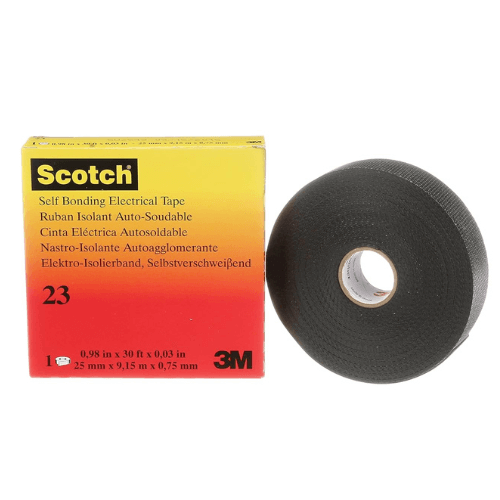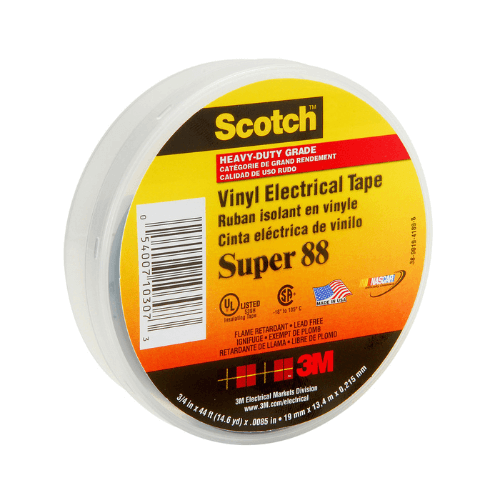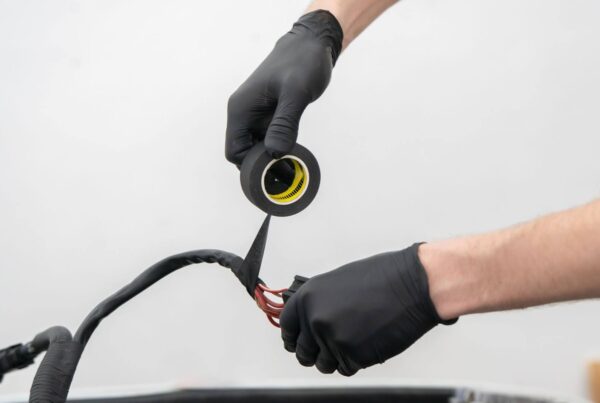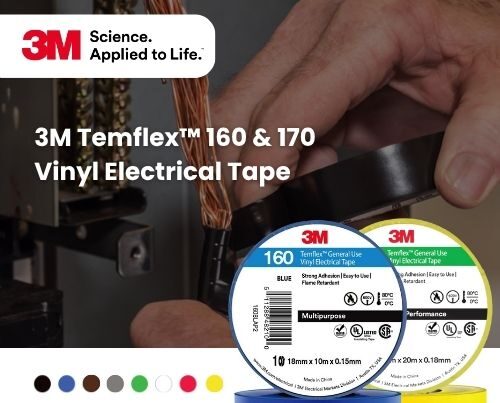Ever see a roll of black tape and automatically think of it as an “electrical tape” you can use for any wiring job?
Many people assume all electrical tapes are the same, but the truth is that different tapes are designed for very different purposes. Using the wrong one can directly affect safety in all industrial, electrical, or maintenance work.
Two of the most commonly used types, rubber splicing tape and electrical vinyl tape, can easily be confused at first glance, since both can be black and commonly linked with electrical use.
However, both tapes differ significantly in composition and application, which directly impacts how and where they should be used.
So, which one should you choose? Let’s compare them to see which fits your work tasks best.
Key Differences Between Rubber Splicing Tape and Vinyl Tape
| Feature / Property | Rubber Splicing Tape | Vinyl Electrical Tape |
|---|---|---|
| Composition & Construction | Self–amalgamating; EPR (ethylene propylene rubber); 4x thicker than vinyl tape | Strong, flexible, abrasion-resistant PVC backing; vinyl tapes are often 0.15 mm – 0.26 mm thick. |
| Primary Function | For splicing and terminating wires and cables with options rated up to 69kV | For bundling, phase marking, and overwrap, often the first and most economical choices for primary and secondary insulation |
| Harsh Environment Performance | Superior resistance to heat; rubber tapes repel moisture and are a great solution for outdoor applications where water can seep in | General indoor use; premium types handle UV, abrasion, and outdoor conditions |
| Conformability & Finish | Offers excellent padding and conformability to irregular surfaces and shapes | Easy to apply/remove, ideal as an outer wrap |
| Elongation | Designed to stretch some up to 1000% | Stretches to more than twice its original length, up to 250% |
Composition and Construction
Rubber splicing tape is self-amalgamating and made of EPR (ethylene propylene rubber). It is about four times thicker than vinyl tape, giving it extra mechanical protection, especially for motor leads exposed to constant vibration.
Vinyl electrical tape uses a strong, flexible PVC backing that resists abrasion. Typically 0.15 mm to 0.26 mm thick, it provides reliable insulation for everyday electrical work.
Primary Function and Application
Rubber tapes shine when high-voltage performance is needed, such as splicing and terminating cables up to 69 kV.
If your job calls for simple identification, bundling, or an economical insulation wrap, vinyl tape is usually the go-to.
Performance in Harsh Environments
Rubber splicing tape holds up well in tough conditions, offering superior heat resistance and moisture protection, which makes it reliable for outdoor applications where water or dampness could penetrate.
Vinyl electrical tape is generally intended for indoor use, though premium ones are designed to withstand UV exposure, abrasion, and certain outdoor conditions.
Conformability and Finish
Rubber conforms tightly around uneven shapes, filling gaps and cushioning sharp edges to create a secure seal. Vinyl, meanwhile, is appreciated for how easily it goes on and comes off and is ideal as an outer protective wrap.
Elongation
When extreme stretch is required, rubber splicing tape has the upper hand, extending up to ten times its original length to ensure a seamless bond. Vinyl tape stretches less but still provides enough flexibility for most routine electrical work.
When to Use Each Tape
Choose Rubber Splicing Tape When:
- You need primary insulation for splices or motor leads
- Sealing connections in wet, oily, or high-heat environments
- You need strong padding with flexibility to fit around irregular shapes
Choose Vinyl Tape When:
- You’re labeling, bundling, or color coding
- Doing general-purpose maintenance
- Needing a UV-resistant overwrap
Can You Use Both Together?
Absolutely. A common best practice is to use rubber splicing tape first for reliable insulation,
then overwrap with vinyl tape to add mechanical strength and UV protection.
This combination delivers both high-voltage reliability and durability for outdoor or demanding applications.
Rubber or Vinyl, 3M has the tape for every task
3M tapes are built to meet the demands of any job. A rubber splicing tape delivers strong protection, moisture resistance, and excellent conformability, making it ideal for challenging conditions.
Vinyl tape offers flexibility, ease of use, and reliable protection for everyday electrical tasks.
By selecting the right tape based on application and environment, you can ensure safety and performance on every job.
For reliable solutions, check out 3M tapes from a trusted electrical tape supplier like Lim Kim Hai Electric.
Contact us to learn more.









